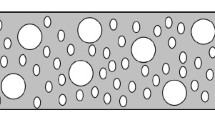Abstract
A feature of porous structure formation in biporous materials is a significant change in pore dimensions without an equal change in the material as a whole, and this depends on pore anisotropy. It is also shown that during sintering of biporous materials shrinkage of micropores affects the formation of the pore structure in a macroporous system. There is a significant difference between biporous and monoporous materials.
Similar content being viewed by others
References
M. Yu. Bal’shin,Powder Metallurgy [in Russian], Metallurgizdat, Moscow (1948).
M. Yu. Bal’shin, “The sintering mechanism,”Zhurn. Tekh. Fiz., No. 4, 686–695 (1952).
V. V. Skorokhod and S. M. Solonin,Physical Metallurgy Bases of Powder Sintering [in Russian], Metallurgiya, Moscow (1984).
N. V. Goncharuk, “Study of features of volumetric effects for superelasticity and shape memory for porous titanium nickelide and development of elastic elements based on it,”Diss. Cand. Tech. Sci., Kiev (1990).
A. G. Kostornov and V. P. Semenets, “Pore structure and hydrodynamic properties of permeable molybdenum-copper composites,”Poroshk. Metall., No. 2, 26–31 (1990).
A. G. Kostornov and V. P. Semenets, “Features of the formation of interparticle contacts during, sintering of porous molybdenum-copper composities,”Poroshk. Metall., No. 3, 25–30 (1990).
A. G. Kostornov and V. P. Semenets, “Physicomechanical properties of porous molybdenum composites,”Poroshk. Metall., No. 4, 59–62 (1990).
V. V. Skorokhod, S. M. Solonin, and L. I. Chernyshev “Study of the sintering mechanism for highly porous materials in the presence of volatile pore-forming agents,”Poroshk. Metall., No. 11, 32–36 (1974).
A. S. Berkman and I. G. Mel’nikova,Porous Permeable Ceramics [in Russian]. Strojizdat, Leningrad (1969).
GOST 26849-86, “Powder materials. Method for determining pore size,” Introduced 03.24.86.
V. V. Skorokhod, S. M. Solonin, L. I. Chernyshev and G. S. Khurtsidze, “Permeable tungsten-copper materials,”Poroshk. Metall., No. 4, 35–38 (1976).
Additional information
Institute for Problems of Materials Science, Ukraine National, Academy of Sciences, Kiev. Translated from Poroshkovaya Metallurgiya. Nos. 9–10(409), pp. 97–103, September–October, 1999.
Rights and permissions
About this article
Cite this article
Chernyshev, L.I. Formation of a porous structure for biporous materials connected with volume changes during sintering. Powder Metall Met Ceram 38, 511–516 (1999). https://doi.org/10.1007/BF02676070
Received:
Issue Date:
DOI: https://doi.org/10.1007/BF02676070




